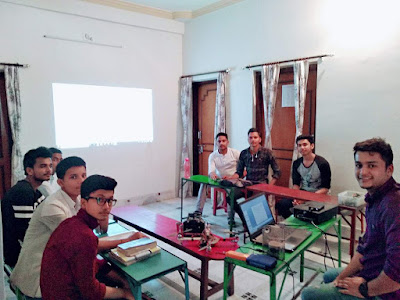To mark the historical day of the first human in space on April 12, 1961, Nepal Astronomical Society (NASO) had a week long celebration as ' A Tribute To The First Human In Space' during April 6-13, 2018. On April 12, 1961, Russian Cosmonaut Yuri Gagarin went to Space and spent 108 minutes around the earth opening a new era of human space exploration.
On 6th of April, an event 'Role of Astronomy and Space Science in Our Society' was conducted at Janaki Secondary Boarding School, Janakpur (Province 2). This event was attended by around 80 students who came to know about the role of astronomy and space science in our society.
 |
| Photo: Participants of 'Role of Astronomy and Space Science in Our Society' held at Janaki Secondary School, Janakpur during a group photo. |
On 7th of April, an event 'The Role of AI in Space Exploration' was conducted at Itahari International College,Itahari (Province 1). Mr. Santosh Ghimire presented his talk on AI and its role in exploration. In order to provide an overview of NASO and WIAN by NASO officials.
 |
| Photo: Participants during a group photo session after the event 'The Role of AI in Space Exploration' held at Itahari Interrnational College, Itahari. |
On 8th of April, an event 'Space Weather Science and Application' was conducted at Gandaki Boarding School, Pokhara (Province 4). This event was attended by around 10 students who came to know about space weather science and it's application.
 |
| Photo: Participants and school authority during the group photo after the event 'Space Weather Science and Application' at Gandaki Boarding School, Pokhara. |
On 9th of April, an event 'Satellite Navigation for Socio-Economic Development of Nepal' was conducted at Southwestern State College, Kathmandu (Province 3). Er. Narayan Dhital, our 'GNSS Working Group' lead and AirMeetsSpace Engineer at DLR, Germany presented his talk to the audience. Click here to access the talk.
 |
| Photo: Participants during a Q/A session of an event 'Satellite Navigation for Socio-Economic Development of Nepal' at Southwestern State College, Basundhara, Kathmandu. |
On 10th of April, a webinar on the topic Connecting the planet from the Space Coast to the Himalayas was held between Ryan L. Kobrick, Ph.D., Assistant Professor of Spaceflight Operations at Embry-Riddle Aeronautical University, Daytona, FL, USA and chairman of Yuri's Night (www.yurisnight.net) and Mr. Suresh Bhattarai, chairman at Nepal Astronomical Society (NASO) to inform the students about the possibilities of space science in Nepal. Click here to watch the webinar.
On 11th of April, an event 'A new Era of Exoplanetary Science: Is there an Earth 2.0?' was held in the premise of Southwestern State College,Kathmandu. During this event a webinar was held with Dr Suman Satyal and students to inform about the exoplanetary science. Click here to watch the talk.
On 12th of April, a wenibar on 'Terrnaut Nepal: An Opportunity to train like a Yuri Gagarin' was held in order to give more insights on Terranaut Nepal. Bishal Manandhar, CEO/Founder at Srothe Code and Suresh Bhattarai, Chairman at NASO discussed on how 'Cosmo Run Space Dash' mobile game (online) can be promoted among Nepali so that they can be a apart of this historic program in Nepal. Click here to watch the webinar.
On 13th of April, an event 'Importance of Autonomous System in Our Daily Life' was held in Shubh Sanskar English Boarding School, Bhairahawa (Province 5). This event helped student to know the importance of autonomous system in our daily life and space too.
 |
| Photo: Participants during an event 'Importance of Autonomous System in Our Daily Life' held at Shubh Sanskar English Boarding School, Bhairahawa. |
Besides these events, we also had an interaction as a radio talk show via Bishaya Prabesh in Image Channel News FM 103.6 MHz. RJ Kamal Rana and NASO chairman Suresh Bhattarai talked about different aspects of space science and status of activities in Nepal. Chick here to listen the full interview.
We would like to express our sincere thanks to Sano Sansar Youth Hostel Pvt. Ltd.-Kathmandu, Janaki Secondary School-Janakpur, Ithari International College-Itahari, Southwestern State College-Basundhara, Gandaki Boarding School-Pokhara, Shubh Sanskar English Boarding School-Bhairahawa, Yuri's Night and IAU Office of Astronomy for Development for their supports to our celebration. We would also like to thank Natraj Tours and Travels Pvt. Ltd. for joining us as our travel partner.
Moreover, those of you who showed their active participations in all these events are our motivation for better event/celebration in 2019 AD!










